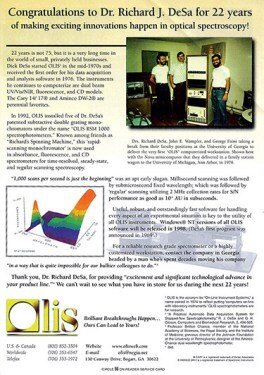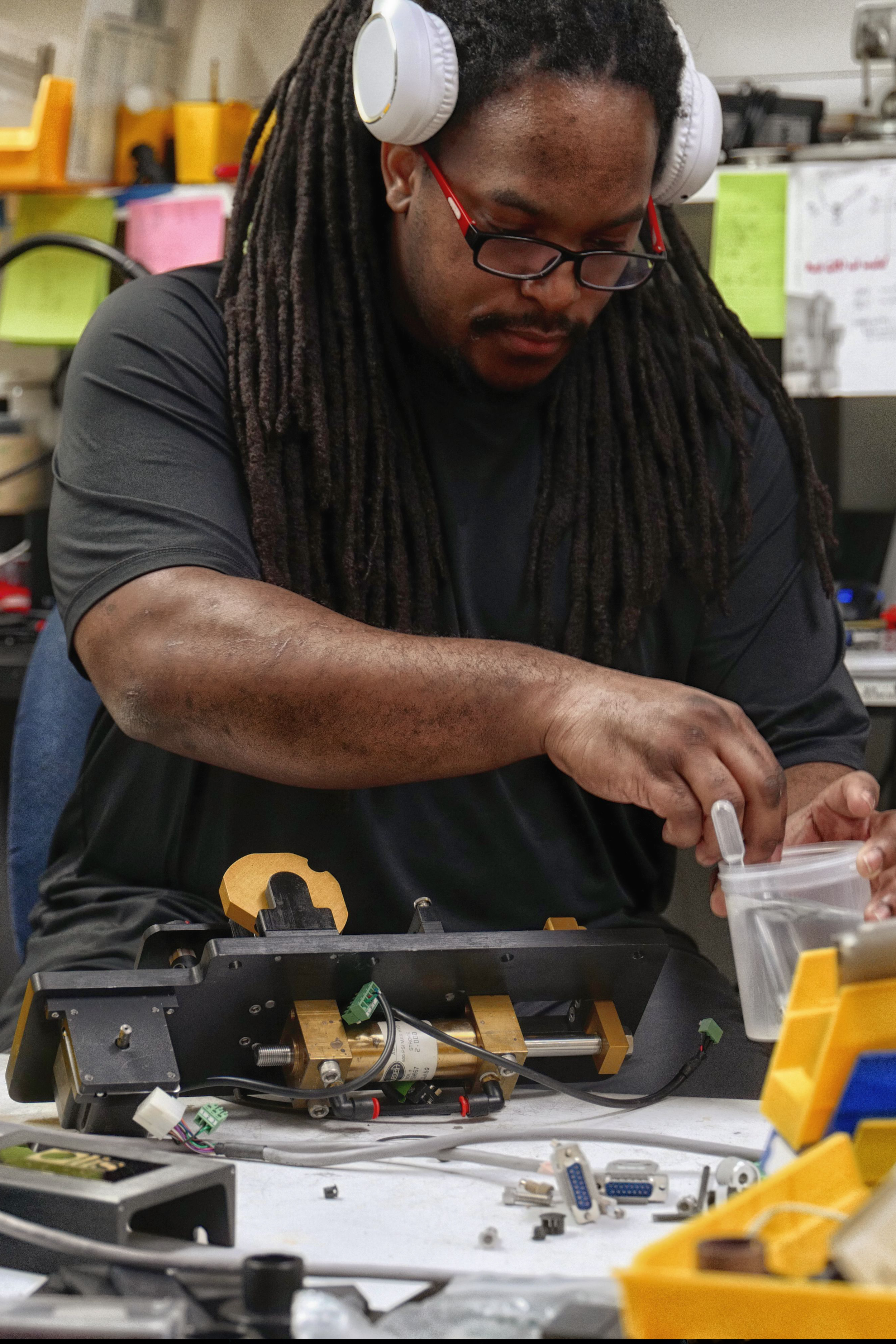The Facts About Circularly Polarized Luminescence Revealed
Table of ContentsNot known Facts About Uv/vis/nirGet This Report on Circularly Polarized LuminescenceOur Circularly Polarized Luminescence IdeasThe smart Trick of Uv/vis/nir That Nobody is Talking AboutSome Of Circularly Polarized LuminescenceNot known Facts About Uv/vis/nirNot known Details About Spectrophotometers Some Ideas on Circularly Polarized Luminescence You Should KnowWhat Does Spectrophotometers Mean?Things about Circularly Polarized LuminescenceSpectrophotometers for DummiesCircularly Polarized Luminescence Things To Know Before You Get ThisAn Unbiased View of Spectrophotometers
It is then scanned through the sample and the referral services. Fractions of the occurrence wavelengths are transmitted through, or shown from, the sample and the reference. Electronic circuits transform the relative currents into linear transmission portions and/or absorbance/concentration values.The transmission of a reference compound is set as a baseline (information) worth, so the transmission of all other compounds are recorded relative to the initial "zeroed" compound. The spectrophotometer then transforms the transmission ratio into 'absorbency', the concentration of particular parts of the test sample relative to the initial compound.
Considering that samples in these applications are not easily available in large amounts, they are specifically suited to being analyzed in this non-destructive strategy. In addition, precious sample can be saved by using a micro-volume platform where as low as 1u, L of sample is needed for total analyses. A quick description of the procedure of spectrophotometry consists of comparing the absorbency of a blank sample that does not include a colored substance to a sample that consists of a colored compound.
Getting My Uv/vis/nir To Work
In biochemical experiments, a chemical and/or physical residential or commercial property is chosen and the treatment that is utilized is specific to that residential or commercial property in order to derive more information about the sample, such as the amount, purity, enzyme activity, and so on. Spectrophotometry can be used for a variety of strategies such as figuring out optimal wavelength absorbance of samples, determining ideal p, H for absorbance of samples, figuring out concentrations of unidentified samples, and identifying the p, Ka of different samples.: 21119 Spectrophotometry is likewise a handy procedure for protein filtration and can also be used as a technique to produce optical assays of a compound.
It is possible to understand the concentrations of a 2 element mixture utilizing the absorption spectra of the standard services of each element. To do this, it is needed to know the extinction coefficient of this mixture at 2 wave lengths and the extinction coefficients of services which contain the known weights of the two parts.

The Only Guide to Circularly Polarized Luminescence
Most spectrophotometers are used in the UV and noticeable regions of the spectrum, and a few of these instruments likewise run into the near-infrared area also. The concentration of a protein can be approximated by measuring the OD at 280 nm due to the presence of tryptophan, tyrosine and phenylalanine (https://papaly.com/categories/share?id=82b22f606fb5496cbfab4f86fdfbca1c).
Nucleic acid contamination can likewise interfere. This technique requires a spectrophotometer capable of measuring in the UV area with quartz cuvettes.: 135 Ultraviolet-visible (UV-vis) spectroscopy includes energy levels that thrill electronic transitions. Absorption of UV-vis light delights molecules that remain in ground-states to their excited-states. Visible area 400700 nm spectrophotometry is used extensively in colorimetry science.
20. 8 O.D. Ink producers, printing business, textiles suppliers, and much more, need the information offered through colorimetry. They take readings in the region of every 520 nanometers along the noticeable region, and produce a spectral reflectance curve or an information stream for alternative discussions. These curves can be used to check a brand-new batch of colorant to examine if it makes a match to specs, e.
How Circularly Polarized Luminescence can Save You Time, Stress, and Money.
Conventional visible area spectrophotometers can not discover if a colorant or the base product has fluorescence. This can make it difficult to manage color issues if for instance several of the printing inks is fluorescent. Where a colorant contains fluorescence, a bi-spectral fluorescent spectrophotometer is utilized (https://www.cgmimm.com/arts-entertainment/olis-clarity). There are 2 major setups for visual spectrum spectrophotometers, d/8 (round) and 0/45.
Scientists use this instrument to measure the amount of substances in a sample. In the case of printing measurements 2 alternative settings are frequently used- without/with uv filter to manage better the result of uv brighteners within the paper stock.
Getting The Circularly Polarized Luminescence To Work
Some applications require little volume measurements which can be performed with micro-volume platforms. As described in the applications area, spectrophotometry can be used in both qualitative and quantitative analysis of DNA, RNA, and proteins. Qualitative analysis can be used and spectrophotometers are utilized to tape spectra of substances by scanning broad wavelength regions to identify the absorbance homes (the intensity of the color) of the substance at each wavelength.

An Unbiased View of Uv/vis/nir
One major element is the type of photosensors that are offered for various spectral areas, but infrared measurement is also difficult since essentially whatever discharges IR as thermal radiation, specifically at wavelengths beyond about 5 m. Another issue is that several products such as glass and plastic soak up infrared, making it incompatible as an optical medium.
Samples for IR spectrophotometry might be smeared in between 2 discs of potassium bromide or ground with potassium bromide and pressed into a pellet. Where aqueous solutions are to be determined, insoluble silver chloride is used to construct the cell. Spectroradiometers, which operate almost like the noticeable area spectrophotometers, are developed to measure the spectral density of illuminants. Obtained Dec 23, 2018. Essential Laboratory Approaches for Biochemistry and Biotechnology (Second ed.). The vital guide to analytical chemistry.
Oke, J. B.; Gunn, J. E.
The smart Trick of Circular Dichroism That Nobody is Talking About

1021/ac50048a728. ISSN0003-2700. Ninfa AJ, Ballou DP, Benore M (2015 ). Essential Laboratory Approaches for Biochemistry and Biotechnology (3, rev. ed.). Hoboken, NJ: Wiley & Sons. p. 77. ISBN9780470924525. OCLC915641828. "Completely Automatic Double Beam - Atomic Absorption Spectrophotometer (AA 8000)". Laboratory Equipment. Labindia Analytical Instruments Pvt. Ltd. "Spectrophotometry Applications and Fundamentals".
The 7-Minute Rule for Spectrophotometers
"Applied Spectrophotometry: Analysis of a Biochemical Mixture". Biochemistry and Molecular Biology Education. Journal of Biochemistry Education.
The Only Guide to Spectrophotometers
U.S. Department of Commerce National Bureau of Standards unique publication; 378. Washington, D.C.: U.S. National Bureau of Standards. p. 2. OCLC 920079.
The process begins with a controlled light that illuminates the evaluated sample. When it comes to reflection, as this light engages with the sample, some is absorbed or discharged. The emitted light journeys to the detector, which is examined, measured, and provided as industry-standard color scales and indices.
Industry governing bodies generally define particular metrics for particular items, such as Tomato and Coffee indices. The streamlined math looks like this: Where R is the reflection coefficient. All terms are assessed over the visible spectrum from 400 to 700 nm. When it comes to transmission, when the light interacts with the sample, it is either absorbed, shown, or sent.
Not known Facts About Circular Dichroism
Examples include APHA (American Public Health Association) for watercolor and pureness analysis, ASTM D1500 for petrochemical color analysis, edible oil indices used in food, and color analyses of beverages. All terms are assessed over the noticeable spectrum from 400 to 700 nm.
Image Credit: Matej Kastelic/ Dr. Arnold J. Beckman and his coworkers at the National Technologies Laboratories initially created the spectrophotometer in 1940. In 1935 Beckman founded the company, and the click here for info discovery of the spectrophotometer was their most ground-breaking creation. Dr. Bruce Merrifield, a Nobel prize-winning biochemist, mentioned that the innovation of the spectrophotometer was "most likely the most essential instrument ever established towards the improvement of bioscience." Before the discovery of the spectrophotometer, chemical analyses took weeks to complete, with 25% precision.
Uv/vis/nir Can Be Fun For Anyone
99% accuracy. In time, researchers kept improving the spectrophotometer design to enhance its performance. For example, the UV abilities of the model B spectrophotometer were improved by replacing the glass prism with a quartz prism. Eventually, the Model DU was developed, including a hydrogen lamp and other improvements. This instrument was used in commercial labs, centers, and chemistry and biochemistry departments.
After 1984, double-beam variations of the gadget were developed. The addition of external software with the arrangement of onscreen display screens of the spectra came in the 1990s. Generally, a spectrophotometer is made up of two instruments, particularly, a spectrometer and a photometer. A fundamental spectrophotometer includes a light, a monochromator, a collimator for straight beam transmission, a cuvette to place a sample, and a photoelectric detector.
The Facts About Circularly Polarized Luminescence Revealed
There are different kinds of spectrophotometers in numerous sizes and shapes, each with its own function or performance. A spectrophotometer figures out how much light is shown by chemical elements. UV/Vis. It measures the distinction in light intensity based on the overall amount of light presented to a sample and the quantity of beam that travels through the sample option
As per the instrument's style, the sample is placed between the spectrometer and the photometer. After the light is gone through the sample, the photometer determines its intensity and shows the reading. A spectrophotometer is used to determine the concentration of both colorless and colored solutes in a service. This instrument is used to determine the rate of a reaction.